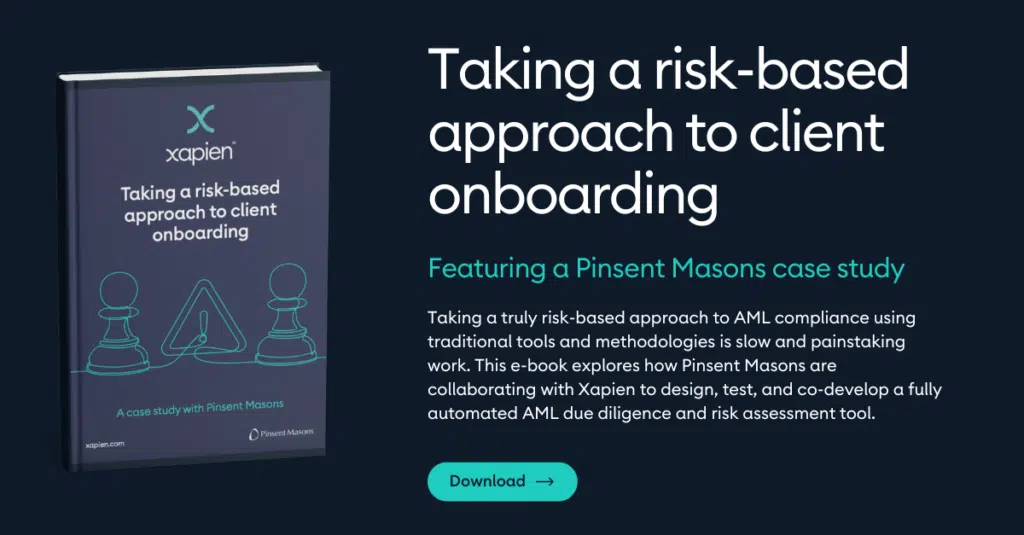
Client intake:
Navigating AML compliance across borders with Bruno Edenogie from Orrick

We recently spoke with Bruno Edenogie from Orrick, Herrington & Sutcliffe about the key challenges compliance teams face in managing AML compliance across multiple jurisdictions. In this recap, we explore how centralising data and integrating technology can streamline AML processes, eliminate inefficiencies, and enhance department collaboration. We also discuss why it is often beneficial to start with a localised approach that leverages regional expertise before centralising to ensure consistency across the firm when building compliance teams in different jurisdictions.
Implementing a firm-wide AML program
AML teams rarely operate in isolation. The data they gather during the AML process can support different teams within the firm, including partners, new business, and even tax and accounts. The conflict between Russia and Ukraine is a good example of why firms need a firm-wide AML program. It makes collecting critical data about directors, beneficial owners, and corporate structures easier to identify potential risks. However, firms that lack this centralised data or approach might struggle.
Communication is one: how do AML teams share their findings with other teams in a way that is useful for risk assessments, understanding sanctions, and monitoring clients over time? Many firms struggle with this because their systems often do not integrate well, despite the technology available. AML data may end up in unsearchable formats like Word documents and PDFs, making it difficult to find and use when urgent issues arise.
Another challenge is the technology itself. For decades, information gathering has been largely manual, involving Google searches to obtain data about individuals and companies. Now, firms have numerous tools that allow for quick information retrieval, but that’s a problem in itself. Having multiple tools complicates the process since teams have to cycle through each to collect and analyse data. This is further complicated by the need to integrate these tools within existing systems and workflows within the firm. Different offices may have unique workflows, making it difficult to create streamlined processes.
Balancing local and global AML standards
Meeting local and global standards for customer due diligence (CDD) can be challenging for firms with an international client base. Cultural differences play an important role since firms in different jurisdictions may have varying approaches to AML. For example, while UK and US firms are generally more aware of AML requirements due to strict regulations, firms in jurisdictions with less stringent oversight may not prioritise AML compliance.
This can prevent firms from implementing a global and firm-wide AML process, since partners and staff in these regions may not be accustomed to requesting sensitive information. In the UK, the increasing fines levied by the SRA have raised awareness of what happens when client and matter risk assessments as well as applying AML controls, aren’t up to scratch. Firms in other jurisdictions might not face the same level of scrutiny, which can vary their approach to AML compliance.
Strategies for overcoming AML challenges
One strategy that’s proven effective is joining external networks. Law firms that work in isolation often struggle to understand what works across different jurisdictions. Being part of a network of peer firms or professionals can help firms stay informed about effective tools, strategies, and best practices. One-on-one conversations within such networks can offer valuable insights that can be adapted to the specific needs of a firm.
Another key strategy is to understand the firm’s internal resources, risk appetite, and the priority level of AML compliance. The firm-wide risk assessments required by the SRA can be time-consuming but provide critical insights into the firm’s vulnerabilities. By understanding the firm’s unique risks, compliance teams can tailor their AML program to address those risks while also choosing the right technologies to support it.
That firm assessment should lead to collaboration with other teams, enabling compliance to communicate the importance of their AML work—not only as a regulatory requirement but as an influence on other areas. For instance, findings from client due diligence provide valuable context for fee-earners by helping them understand a client’s background, and interests, and identify cross-selling opportunities. It also helps bridge the gap between departments that often operate in silos. When presented this way, AML compliance gains more traction.
Choose technology partners over tools
Choosing the right technology partner is crucial. The shift to cloud technology took a while due to client and firm hesitation. The same is happening with AML technology. Law firms rely heavily on trust and reputation, so they go with data providers who are reliable. This is especially important since, in an audit, you need to prove the provenance of your data to show you’ve correctly identified the client and beneficial owner.
One question that often comes up among compliance leaders is how best to assess technology partners and their offerings. Law firms need technology that genuinely addresses pain points, like improving efficiency and upskilling staff by reducing repetitive tasks. The critical question to ask is: “What problem is this technology solving for us?”
Automation is great, but it only tackles one part of the broader challenges firms face. If compliance is using four different tools to complete an AML process, how can they consolidate that into one or two integrated solutions? Ideally, technology should work seamlessly with existing systems, automating routine tasks without requiring extra steps that could lead to process inefficiencies
Building a business case for AI and automation in AML
When building a business case for AI and automation, it’s important to focus on specific pain points within AML processes. Technology should not just automate tasks for the sake of automation but address the challenges that AML teams face, such as improving efficiency, reducing manual tasks, and streamlining data collection and analysis. For example, many firms use multiple tools to onboard a client, which can be time-consuming and inefficient. A good solution would consolidate multiple steps into a more integrated system, reducing the need for extra work and making the process more fluid.
Understanding how AI can benefit other teams and departments is also crucial. Compliance teams should focus on adding value across the firm. Often, lengthy and detailed due diligence reports are beneficial for compliance but not digestible for fee-earners who just need to know if there’s an issue, or can they proceed. Highlighting key risk factors makes compliance more effective and helps maintain ongoing monitoring.
When selecting a technology partner, it’s important to consider whether they can help compliance teams distil reports into concise, digestible formats. For example, long reports with repetitive entries, like multiple hits on a common name, can become overwhelming and counterproductive. Simplified formats with just relevant information build trust, allowing fee-earners to focus on their work while staying compliant.
Choosing the right client onboarding technology
When considering client onboarding technology, it’s essential to partner with a trusted provider and engage internal stakeholders in product demonstrations to understand the tool’s functionality and potential benefits fully. Gathering input from colleagues with technical expertise is invaluable, as they can evaluate compliance and risk factors specific to a client onboarding tool, beyond just AML rules, by identifying underlying technological risks. It’s important to recognise that while “AI” is often used broadly, some solutions marketed as AI might only offer basic automation. Engaging experts across technical, operational, and risk domains ensures a comprehensive assessment and informed decision-making for implementing the right client onboarding technology for your firm.

Learn why magic circle firms use Xapien
Monthly learnings and insights to your inbox
Xapien streamlines due diligence
Xapien's AI-powered research and due diligence tool goes faster than manual research and beyond traditional database checks. Fill in the form to the right to book in a 30 minute live demonstration.